Physical Address
304 North Cardinal St.
Dorchester Center, MA 02124
The muscles of facial expression all arise from the second branchial arch, are concentrated in the central facial region, and receive their motor innervation from the facial nerve (cranial nerve VII)
The superficial musculoaponeurotic system (SMAS) is a fibromuscular layer that ensheathes and connects the facial muscles and plays an intricate role in coordinating facial expressions
The SMAS can be utilized as a guide to dissection, tissue mobilization, and closure, thereby minimizing trauma to neurovascular tissues
The three branches of the trigeminal nerve (cranial nerve V) provide sensory innervation to the face, while various branches of the cervical plexus provide sensory innervation to the neck, parts of the ear, and posterior scalp
Familiarity with the muscular and neurovascular structures of the head and neck region allows the surgeon to properly approach the “danger zones”, e.g. Erb's point in the neck, the temporal nerve as it crosses the zygomatic arch, and the marginal mandibular nerve at the jawline just anterior to the masseter muscle
The rich and anastomosing vascular supply of the face and scalp, derived from both the external and internal carotid arteries, explains the excellent healing potential and viability of local flaps and grafts in this region
Cosmetic subunits and the junction lines separating them should be considered when planning excisions, repairs and cosmetic procedures of the head and neck
The dermatologic surgeon must have a comprehensive knowledge of regional anatomy in order to obtain acceptable operative results. Proper tissue movement on the face and neck is essential for obtaining closures that are under minimal tension without cosmetic distortion or functional loss of vital structures. In addition to reducing postoperative morbidity, a fundamental appreciation for the macromechanics of the head and neck leads to preservation of tissue viability as well as sensory and motor innervation . The fascial planes, vascular supply, innervation, and cosmetic subunits of the face must be considered when planning a surgical or cosmetic procedure. In order to accurately and thoroughly counsel patients regarding procedural risks and benefits, the surgeon must have a thorough appreciation of head and neck anatomy.
It is possible to pinpoint underlying anatomic structures of the head and neck by observing surface anatomy. The bony structure of the face serves as a simple anatomic framework ( Fig. 142.1 ). The supraorbital ridges are formed by the frontal bone and are more prominent in men. The supraorbital foramen transmits the sensory supraorbital nerve (from the ophthalmic division of the trigeminal nerve) and its associated artery and vein. This foramen is palpable on the bony supraorbital ridge at the vertical midpupillary line. This line lies approximately one finger-breadth lateral to the lateral nasal root or 2.5 cm lateral of the midline on the face ( Fig. 142.2 ). Other important foramina lie in this midpupillary line and transmit important neurovascular bundles. The infraorbital foramen is located 1 cm below the infraorbital rim in the midpupillary line. It transmits the sensory infraorbital nerve (from the maxillary division of the trigeminal nerve) and its associated artery and vein. The mental foramen lies in the same vertical line in the midportion of the mandible. The mental neurovascular bundle emerges here as a terminal sensory branch of the mandibular division of the trigeminal nerve.
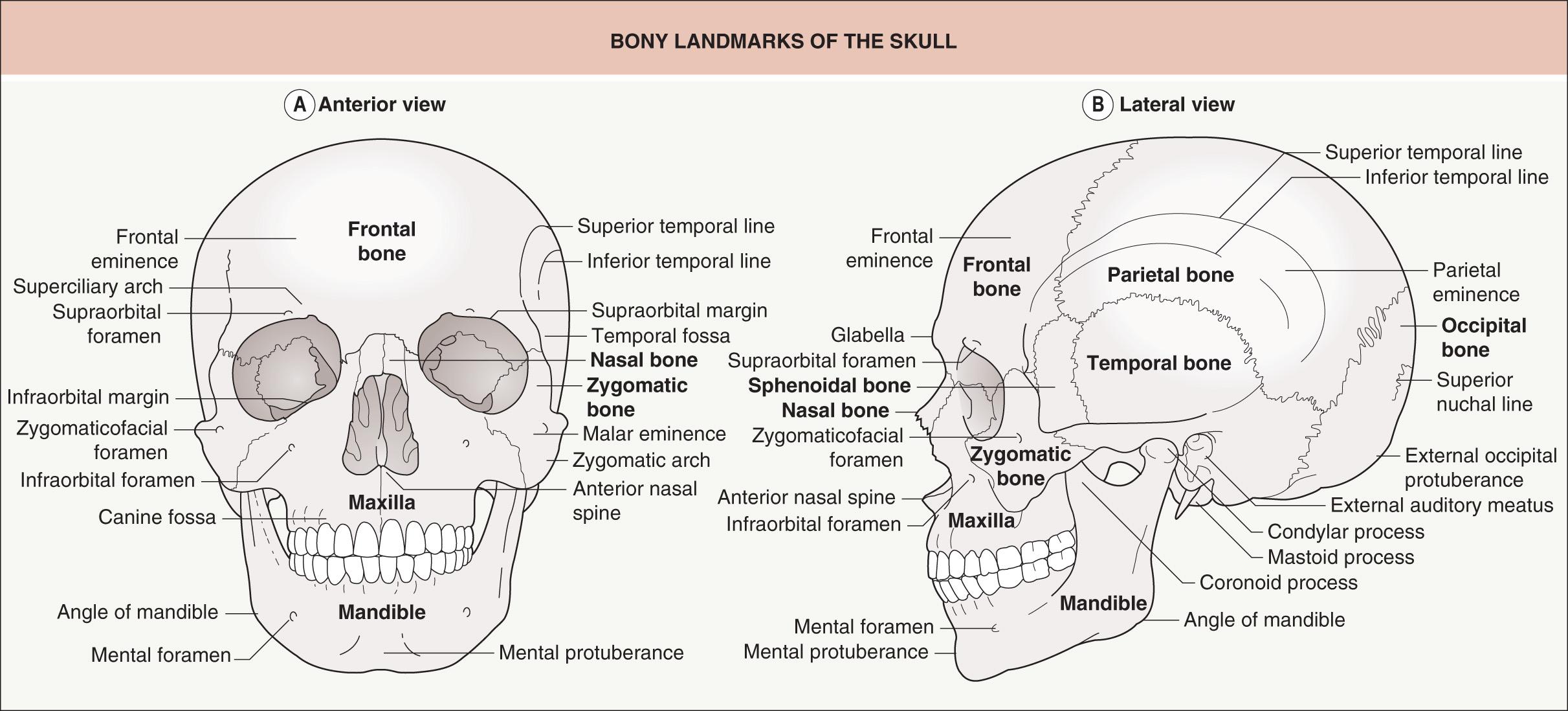
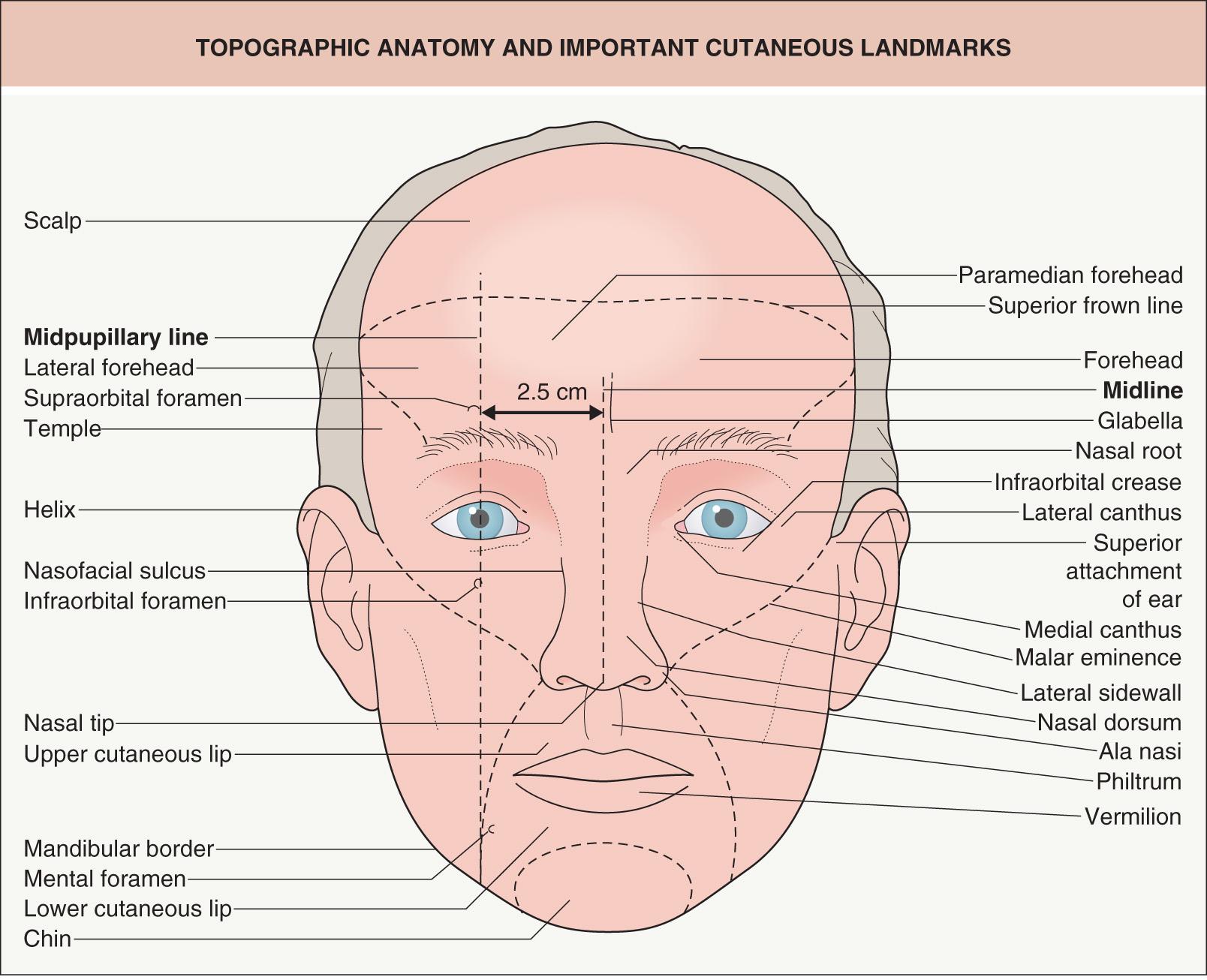
The anterior border of the temporalis muscle can be palpated in the temporal fossa above the zygomatic bone. The latter bone forms the malar eminence of the cheek. The buccal fat pad provides fullness to the cheek; elderly or cachectic patients often have very prominent zygomatic arches. These arches form the widest points on the face and serve as the point of attachment for several muscles of facial expression and for the masseter muscle. The masseter muscle spans the zygomatic arch and mandibular ramus, serving as a muscle of mastication innervated by a motor branch of the trigeminal nerve (see below). This muscle is easily palpated by clenching the jaw.
The parotid gland lies beneath the subcutaneous fat of the lateral cheek and is invested by parotid fascia. The superficial lobe of the parotid covers the posterior half of the masseter muscle and extends from the preauricular sulcus to the angle of the mandible. The deep lobe lies on the medial side of the ramus of the mandible and is connected to the superficial lobe by an isthmus. The superficial temporal artery and vein, as well as branches of the facial nerve (which provides motor innervation to the muscles of facial expression), course through the parotid gland in channels between glandular tissue . The duct of the parotid gland (Stensen's duct) travels across the anterior surface of the masseter muscle ( Fig. 142.3 ). After crossing the muscle surface, the duct penetrates deeper to pierce the buccinator muscle and eventually drains into the mouth at the level of the second upper molar. It can be palpated as a “cord” crossing a clenched masseter muscle. If the duct is transected, a chronic draining fistula will form, requiring corrective surgical intervention. Stensen's duct can be identified topographically by drawing a line between the tragus and the midportion of the cutaneous upper lip. The duct traverses the masseter muscle at the middle one-third of this line (see Fig. 142.3 ).
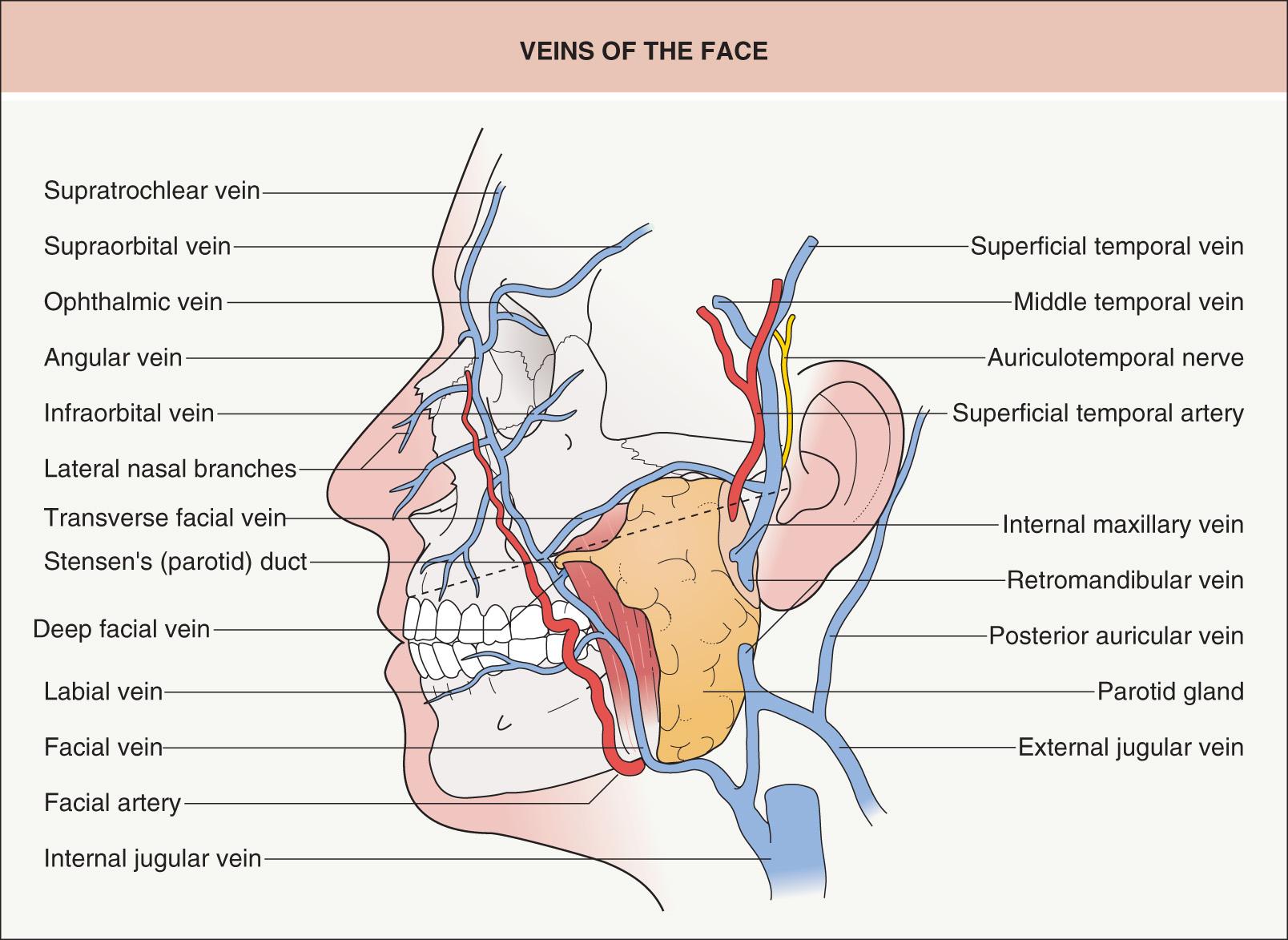
Several structures of importance can be located by observing the surface anatomy of the neck. The sternocleidomastoid muscle is comprised of two heads originating from the sternum and the medial one-third of the clavicle. It inserts onto the outer surface of the mastoid process and nuchal ridge, dividing the neck into anterior and posterior triangles. A dermatologic surgeon should be familiar with the anatomic structures that lie within each of these topographic triangles ( Fig. 142.4 ). Although the sternocleidomastoid muscle covers and protects most of the major anatomic structures in the neck, the external jugular vein traverses its surface with many cutaneous sensory nerves of the cervical plexus. In addition, the posterior triangle of the neck contains trunks of the brachial and cervical plexus as well as the spinal accessory nerve (cranial nerve XI). Cranial nerve XI innervates the trapezius muscle of the back. It may be damaged when operating in this posterior triangle ( Fig. 142.5 ). This may result in chronic shoulder and neck pain, shoulder drop and trapezius atrophy, “winged” scapula, arm paresthesias, and the inability to abduct the arm greater than 80°.
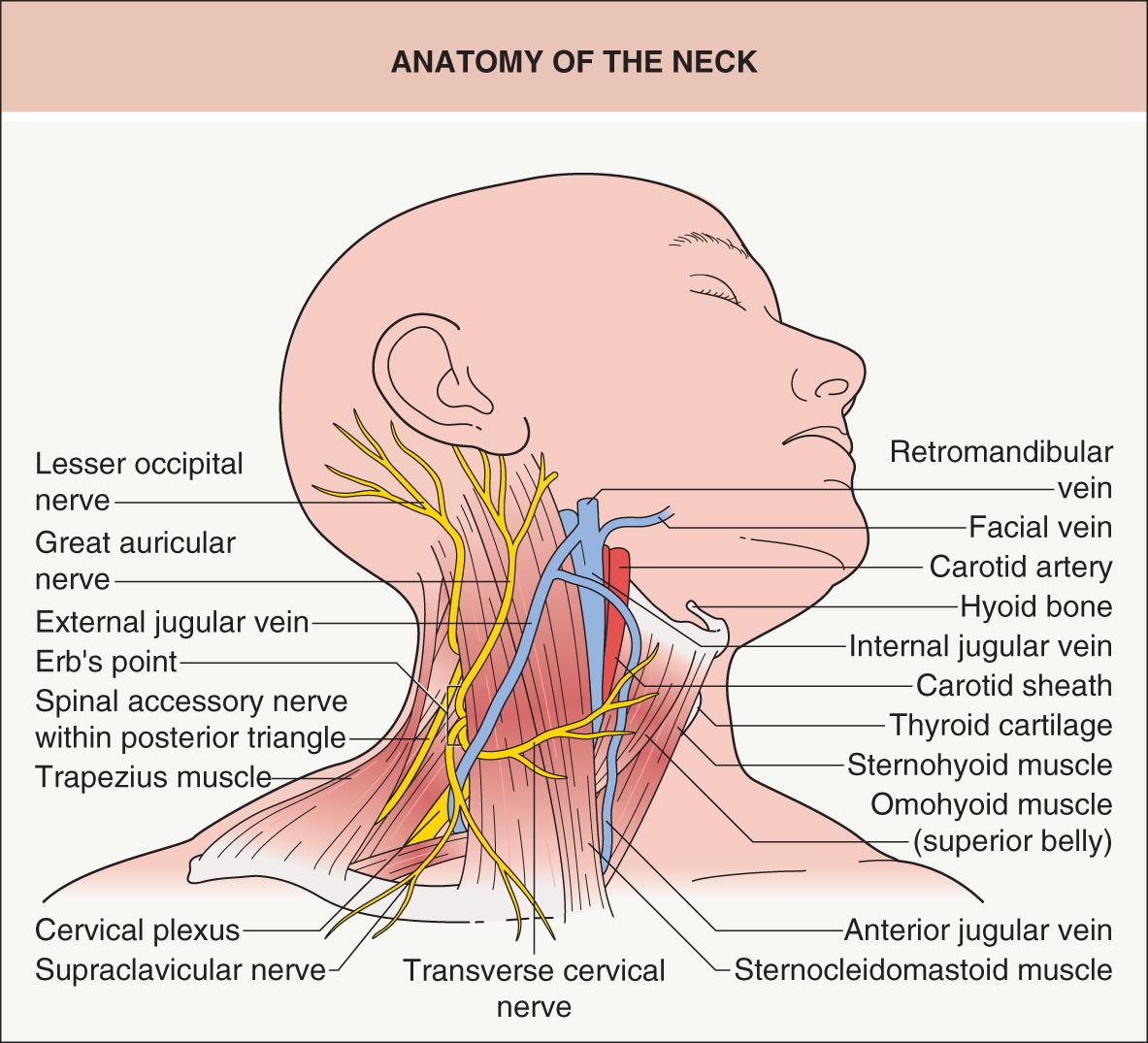
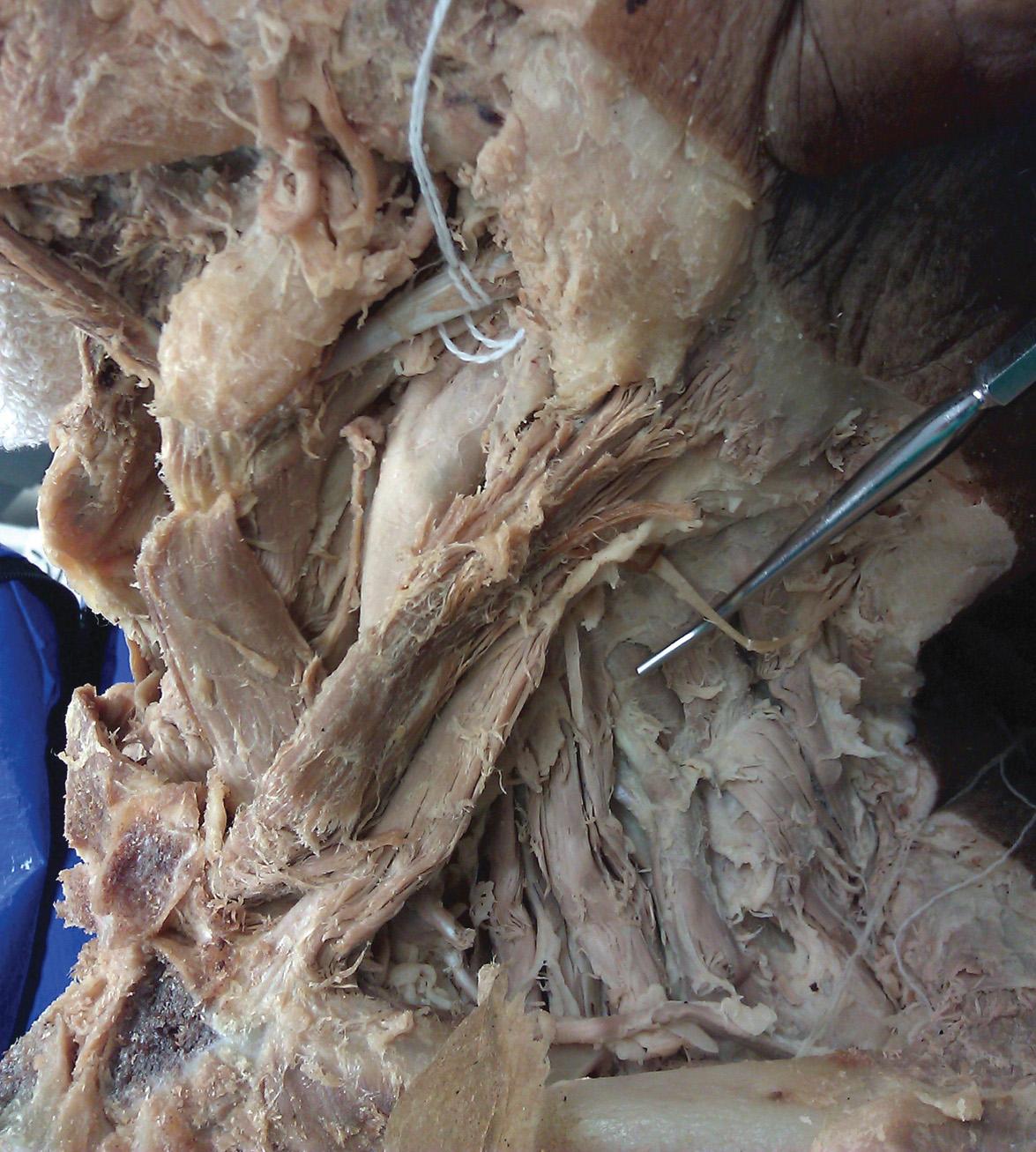
Erb's point designates the area where the cervical plexus emerges from the posterior margin of the sternocleidomastoid muscle (see Figs 142.4 & 151.6 ). The spinal accessory nerve also courses through this area on its way to the trapezius muscle (see Fig. 142.5 ). This surgical danger zone can be visualized by drawing a line connecting the angle of the jaw to the mastoid process. In an adult, a perpendicular line dropped 6 cm from the midpoint of this connector will intersect the posterior border of the sternocleidomastoid where the spinal accessory nerve and cervical plexus emerge . Extreme caution is warranted when dissecting around these anatomic structures, in order to avoid loss of innervation to the trapezius muscle.
Collagen and elastin afford flexibility and extensibility to the skin, and derangements of their architecture or abundance contribute to the aging process. Wrinkles (rhytides) develop over time in predictable areas on the face. The fine wrinkles seen on an aged face may be referred to as the skin tension lines ( Fig. 142.6 ); on the body, skin tension lines are an important consideration when designing surgical excisions (see Ch. 146 ). Many environmental and intrinsic factors, such as ultraviolet exposure, smoking, underlying facial muscles, etc., contribute to the appearance of the expressive human face. A thorough understanding of the derivation and implications of skin tension lines is essential to successful dermatologic surgery.
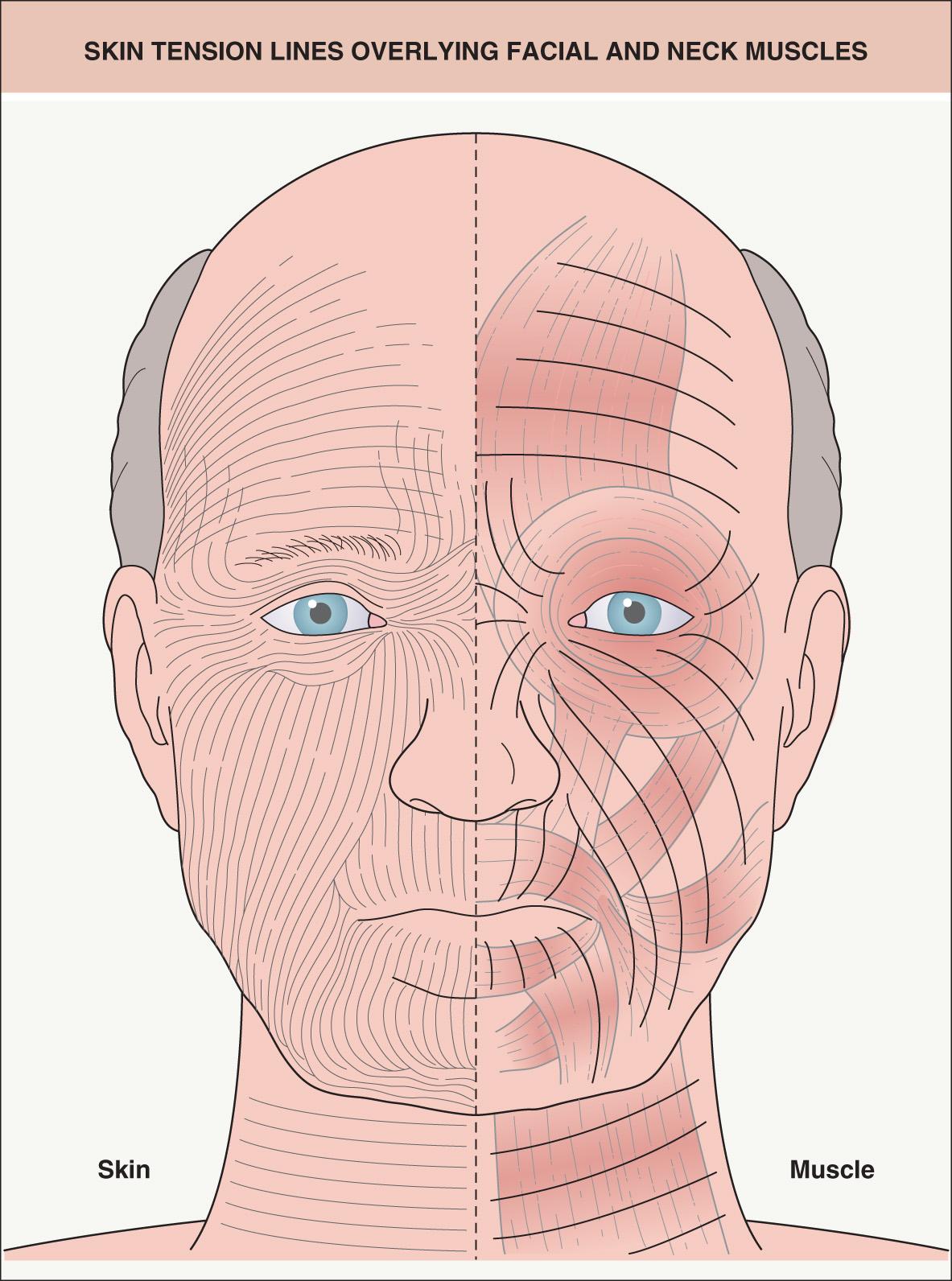
Continuous tension is exerted on the skin of the head and neck by the muscles of facial expression. A complicated network composed of muscles, elastin, fibrous septae of collagen, and fascial planes contributes to this stress, which eventually results in sagging, wrinkling and redundant skin. Collagen is flexible but much less extensible than elastic fibers. The resistance to tensile forces by collagen promotes a “youthful” appearance. Over time, the prolonged tension exerted on the skin from many factors forces collagen fibrils to accommodate by way of elongation. Eventually, aged skin manifests the consequences of persistent skin tension. The collagenous tissue becomes increasingly intertwined, diminished in volume, and permanently elongated. This causes the accentuation of skin tension lines .
Elastic fibers promote extensibility (i.e. the ability of skin to stretch) and elasticity (i.e. the skin's capacity to restore its original shape after physical stress). They contribute to the skin tension lines by promoting vector distribution of tension along fascial planes. The elastic properties of the skin explain the phenomenon whereby round surgical wounds relax into an axis parallel to the patient's wrinkles. Tension vectors are increased parallel to the skin tension lines and are diminished perpendicular to them; therefore, the linear appearance of wrinkles is often directed perpendicularly to the underlying muscle fibers of facial expression (see Fig. 142.6 ). The continuous tension exerted on the overlying skin by these muscles challenges the competency of elastic tissue and collagen. They induce this geometric linearity via fibrous connections to the dermis via the SMAS. For example, the forehead undergoes transverse wrinkling due to contractions of the frontalis muscle, whose fibers run in a cephalocaudad direction. Periocular rhytides are often radially oriented due to underlying contraction of the orbicularis oculi. Similarly, perioral wrinkling occurs under the influence of the concentric orbicularis oris muscle, which induces a radial arrangement of skin tension lines as well. The procerus muscle causes transverse nasal root lines, and vertical glabellar lines are determined by the corrugator supercilii muscles ( Fig. 142.7 ).
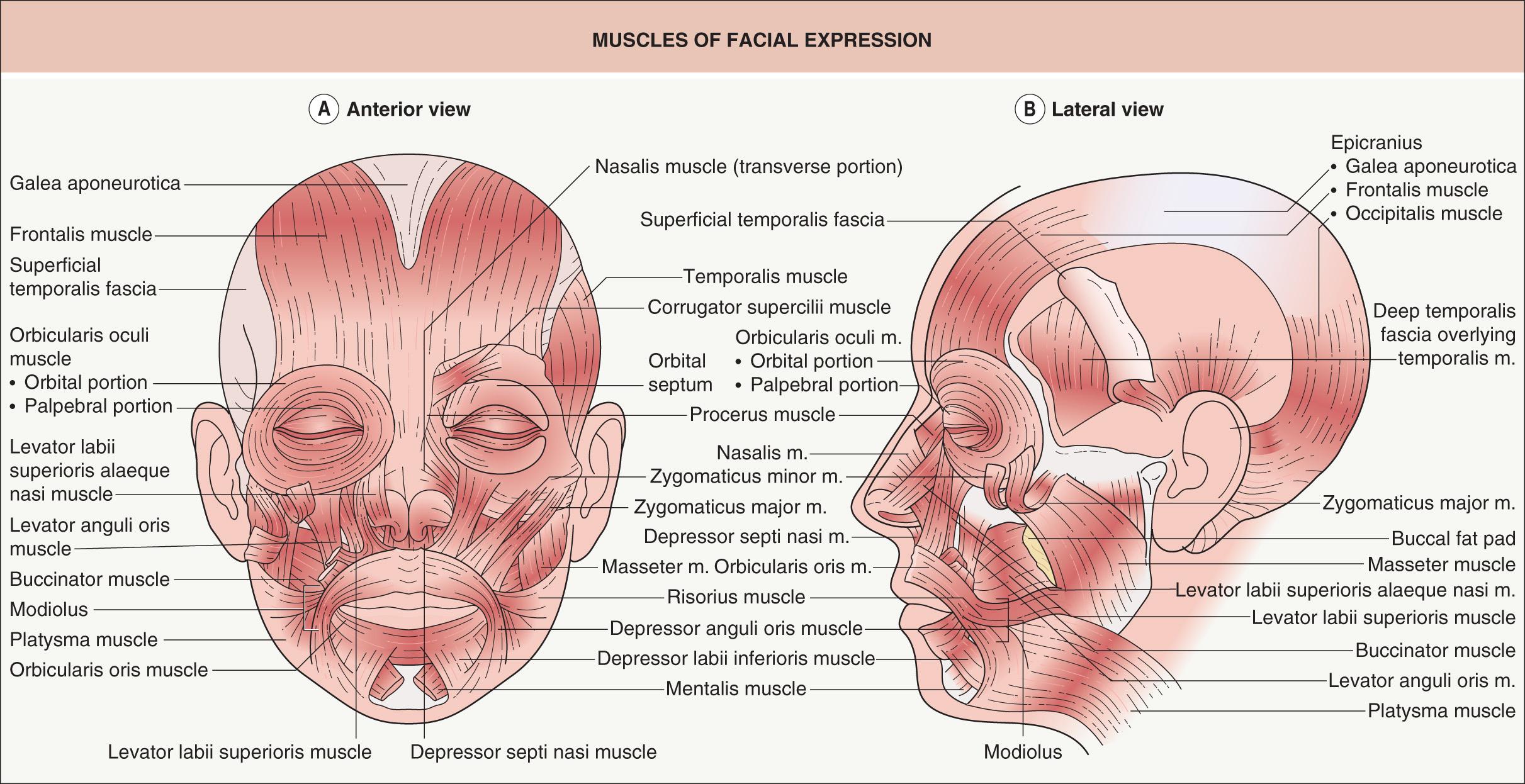
Knowledge of these functional anatomic principles is necessary in surgical and cosmetic dermatology. For example, the successful use of botulinum toxin for the diminution of rhytides requires an understanding of the anatomic relationships between various muscle groups and their influence on the skin tension lines. Proper surgical technique entails placement of incision lines parallel to the skin tension lines in order to achieve excellent cosmesis. It is helpful to determine and even sketch the patient's skin tension lines with a gentian violet pen. This will help orient the axis of incision and guide the closure parallel to, and preferably “buried” within, individual lines of tension.
There is often a significant amount of recruitable or “redundant” skin within the skin tension lines. In addition, “extra” skin may also be found in the preauricular folds, glabella, nasolabial folds, and the “jowls” or lower cheeks . These tissue reservoirs can be used as donor sites for flaps (see Ch. 147 ) and grafts (see Ch. 148 ) in order to achieve surgical closure under minimal tension.
Cosmetic units (i.e. aesthetic, topographic or regional units) represent the major structural areas of the face that are separated by contour or junctional lines or boundaries ( Fig. 142.8 ). Units are designated based upon their similarity in topographic anatomy, texture and color, solar exposure, hair density, and sebaceous features. The forehead, temples, eyelids, nose, cheeks, upper and lower lips, chin, and ears represent the major cosmetic subunits of the face. Within each division, smaller units are designated that further guide surgical closures. The junctional or contour lines between cosmetic units serve as excellent locations to place incisions and hide surgical scars. They include the hairline, alar and nasolabial creases, eyebrows, the philtrum, the labiomental crease, and the upper and lower vermilion–cutaneous interfaces (see Figs 142.2 & 142.12 ).
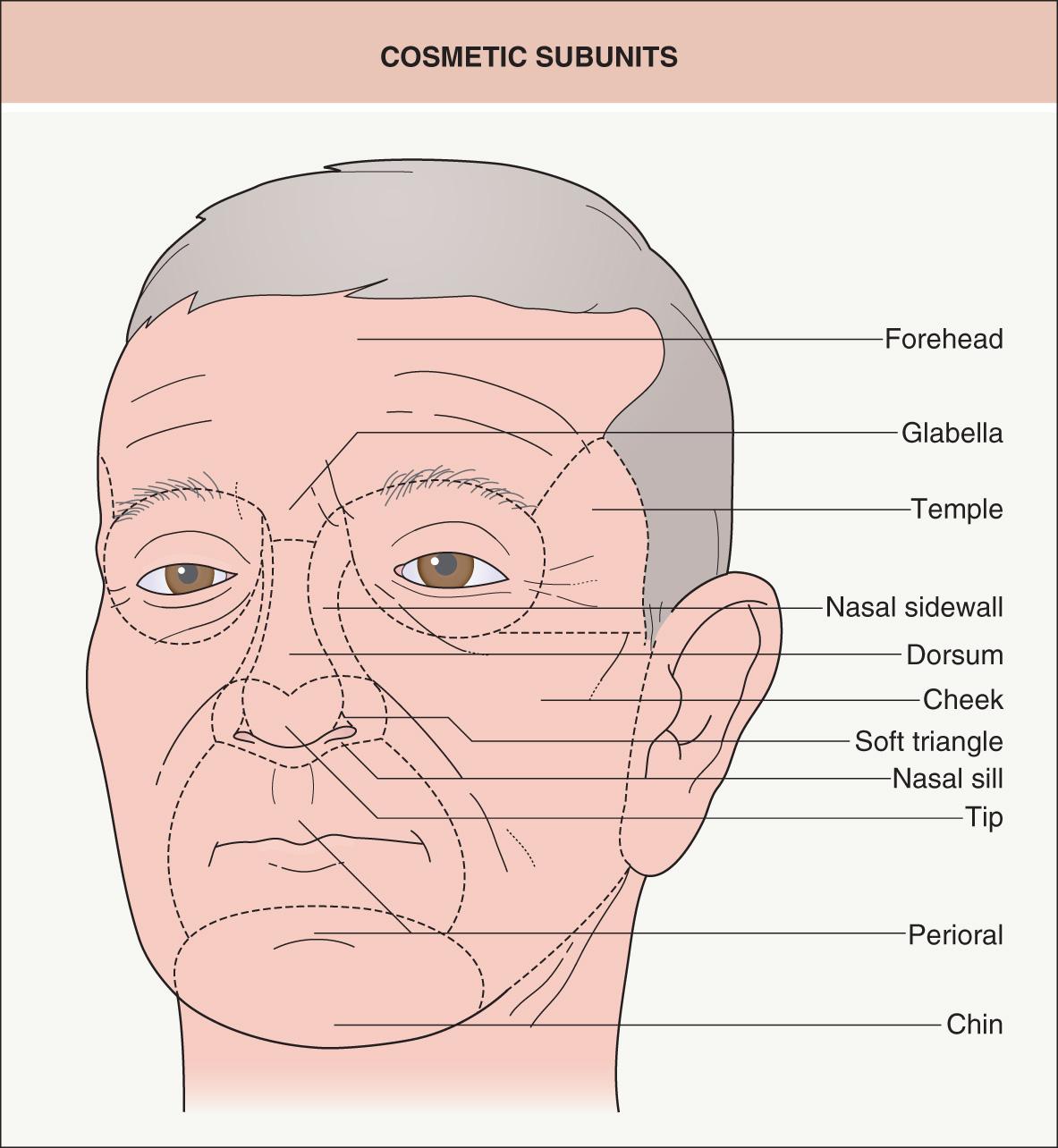
In general, defects should be repaired with tissue from within the same cosmetic unit in order to preserve topographic consistency and to match skin color and texture. If this cannot be achieved, it is reasonable to utilize tissue from an adjacent aesthetic unit, which will most closely match the skin of the recipient cosmetic unit. The goal is to optimize the match in skin texture, color, actinic damage, and thickness. Scars that cross aesthetic units and boundary lines are obvious and often cosmetically unacceptable. A primary goal of cutaneous surgery is to “respect” the cosmetic subunits.
An appreciation for cosmetic units and contour lines also helps the surgeon determine areas of “recruitable” tissue for closures. Redundant or freely mobile skin can be mobilized from the preauricular folds, neck, nasolabial folds, temple, glabella, the lower and lateral cheeks, and the “jowls”. The potential for such tissue recruitment depends on the patient's age, degree of actinic damage, and skin elasticity, which varies from patient to patient. Areas of redundancy or high elasticity may serve as excellent donor sites within or adjacent to the cosmetic subunit which contains a given surgical defect. For example, cheek advancement flaps and temple to lateral forehead advancement and rotation flaps are frequently used for defect repairs.
The forehead unit can be divided into the glabella, temple, and supra-eyebrow aesthetic subunits. The transverse creases of this region serve as excellent sites to place cosmetically acceptable incisional scars. The eyelids represent a major cosmetic subunit of the face whose subdivisions correspond to portions of the orbicularis oculi muscles ( Fig. 142.9 ). The inferior pretarsal portion of the upper eyelid is relatively fixed, while the preseptal unit becomes increasingly redundant with age. Over time, progressive laxity of the preseptal unit can cause functional visual impairment in some patients. It is the preseptal unit of the palpebral portion of the lid that is reduced in blepharoplasties. The infraorbital crease lies between the lower eyelid and the upper cheek.
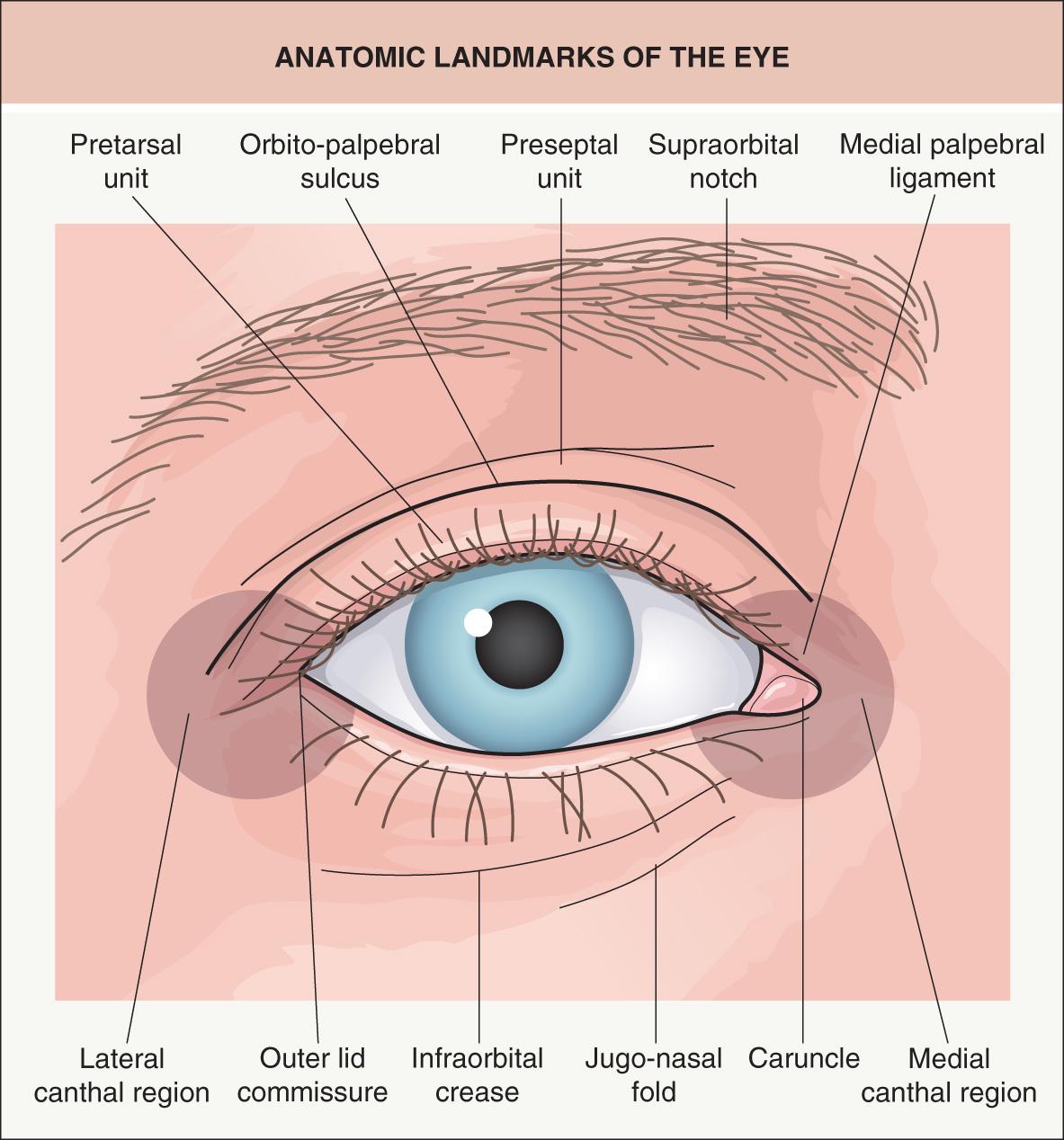
Nasal cosmetic subunits include the alar groove (which defines the ala nasi) and the columella, which extends from the nasal tip to the junction with the upper cutaneous lip. The dorsum, lateral sidewalls, soft triangles, root and nasal tip are important landmarks that pose a significant challenge in dermatologic surgery ( Fig. 142.10 ). The nasal tip unit forms the shape of a chevron or heart due to the anatomy of the nasal cartilage ( Fig. 142.11 ). When possible, surgical defects should be contained within the boundaries of a given nasal subunit in order to effect acceptable cosmesis .
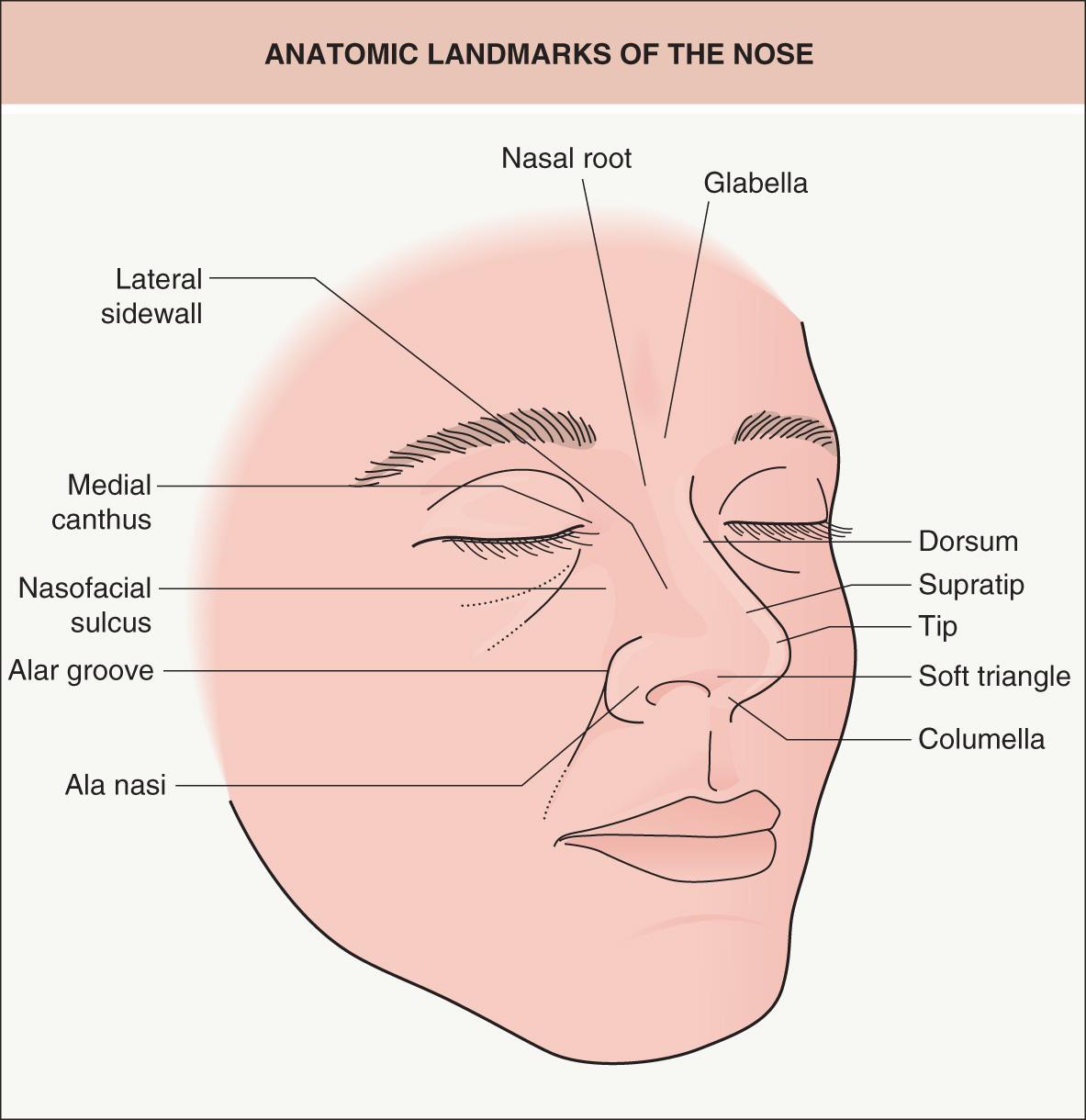
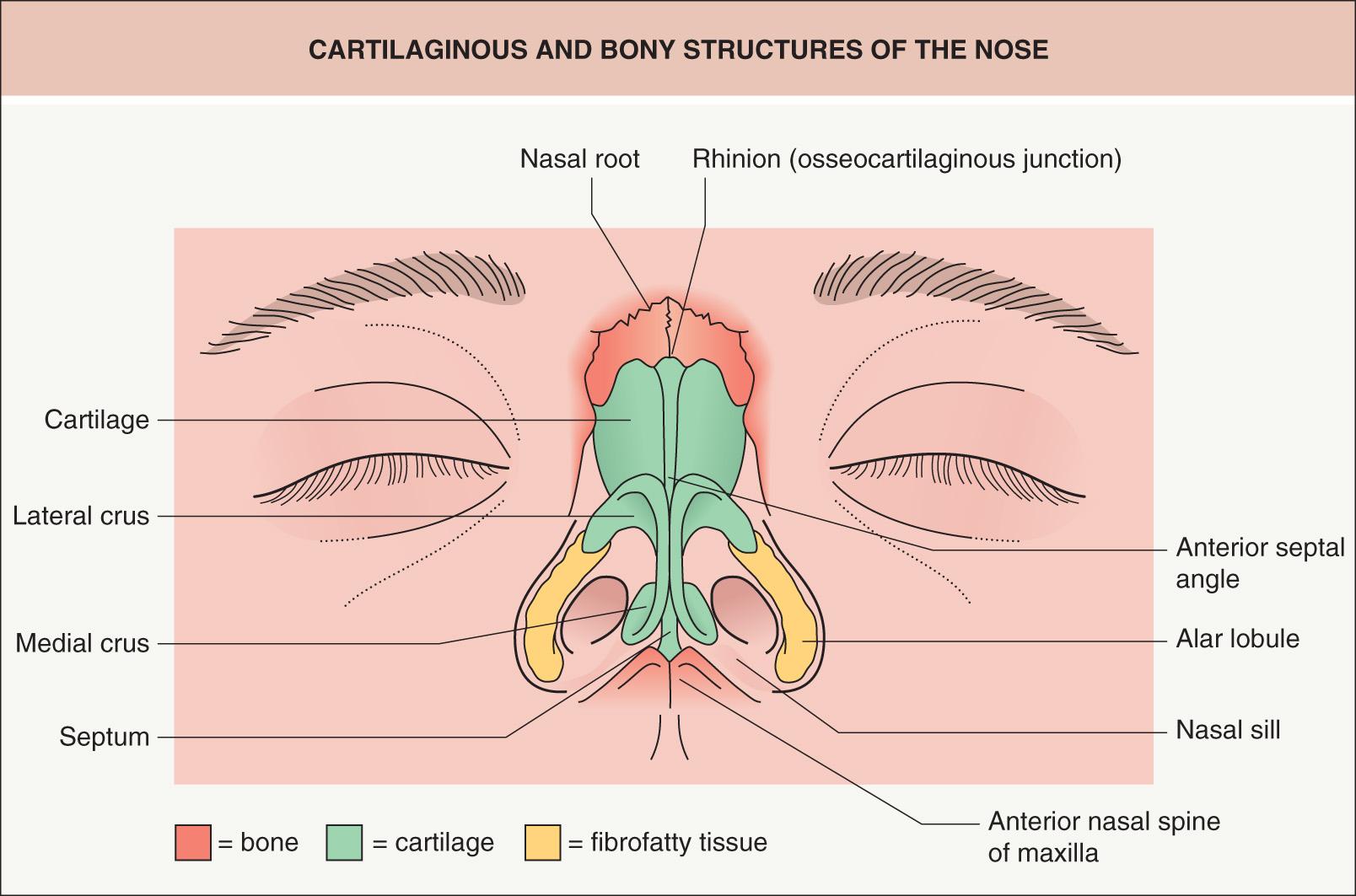
The philtrum is located above the upper vermilion lip and extends superiorly to the columella of the nose ( Fig. 142.12 ). Because it is a midline structure, even minimal anatomic distortion results in a poor cosmetic outcome. The vermilion lip extends from the vermilion lip–cutaneous junction to the mucous membrane junction. It is a modified epithelium that usually does not contain adnexal structures or salivary glands. Approximation of the vermilion border is crucial to maintaining facial symmetry. The melolabial or nasolabial crease serves as a useful landmark that separates the cheek from the mouth and chin aesthetic units. It is an ideal place to hide suture lines and often serves as a generous donor site for repairs.
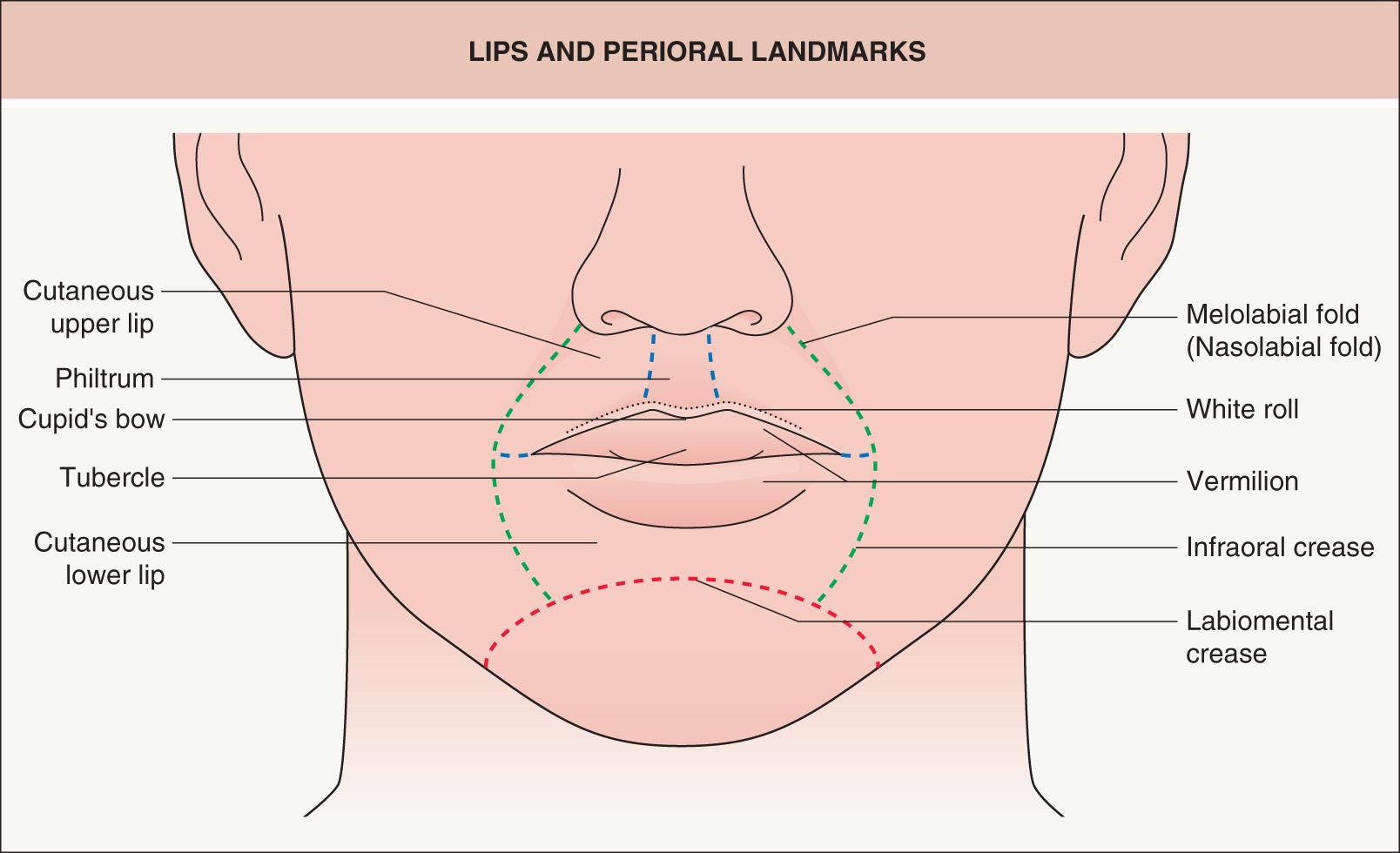
The external ear (auricle or pinna) consists of a single cartilaginous plate that results in the complex curves and folds of the ear ( Fig. 142.13 ). The skin is loose on the posterior portion but tightly adherent on the anterior surface.
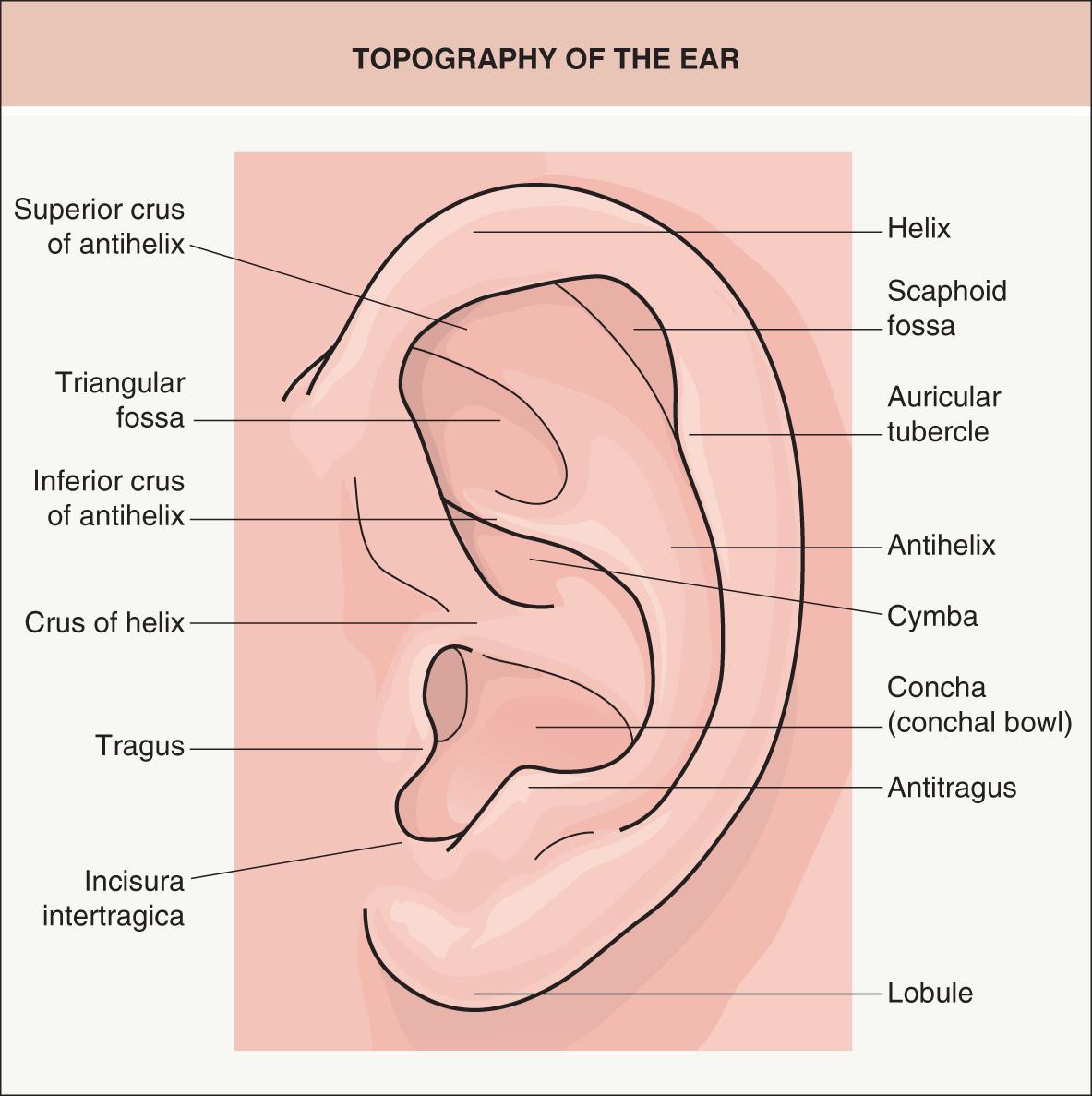
Free margins of the face are anatomic structures that are in some way discontinuous with adjacent skin. They include the lips, helices, eyelids and nostrils. These areas deserve special attention from the dermatologic surgeon because they do not have evenly distributed tension vectors. This characteristic makes the free margins especially vulnerable to any iatrogenic directional pull. Surgical closures, wound healing, and scar contraction can cause these free margins to lose their cosmetic or functional integrity. Ectropion (eyelid eversion) or eclabium (lip eversion) may ensue. Both primary elliptical closures that are parallel to a free margin and second intention healing are not frequently used in these areas.
The opposing force inflicted upon a free margin depends on closure axis orientation, flap or graft design, and the tensile strength and elasticity of the skin. Aged skin is often less able to resist directional vectors. The lower eyelid often becomes especially lax with cumulative actinic damage and age. The “pinch” or “snap” test can be used in free margin evaluation by gently pulling the lower lid away from the eye. Upon release, a competent lower lid should assume its original shape against the globe, while a lax lid will regain its configuration slowly . Instruct the patient to open his or her mouth and gaze upwards while simulating closure options under the eye. This generates the maximum intraoperative tension on the lower eyelid and can help to estimate the risk for distortion of this free margin. No more than 2 mm of inferior pull or “drag” on the lower eyelid can generally be tolerated during cutaneous surgical repairs. Any additional inferior tension puts the patient at high risk for ectropion .
Maintenance of cosmesis and function of the lip vermilion is of utmost importance. Elliptical closures often create drag on these free margins, but careful redirection of tension vectors may allow simple closures here as well. Flaps that can be performed in this area are reviewed in Chapter 147 . Although the helical rims are free margins, they are far more “forgiving” than the aforementioned sites. Second intention healing and axial elliptical closures can achieve excellent results on the ear. The tissue is easily dissected and the posterior auricular skin provides excellent mobility. Most patients have some ear asymmetry at baseline, thus making this free margin less cosmetically sensitive.
The nasal tip, alae, and adjacent lateral sidewall require special consideration due to their classification as “free margins” and the underlying cartilage framework that prevents significant tissue mobility. Elevation and distortion of the nasal rim may occur if second intention healing or simple primary closure is attempted. Full-thickness skin grafts and transposition or rotation flaps from adjacent areas are particularly appealing repairs in this cosmetically sensitive area .
Become a Clinical Tree membership for Full access and enjoy Unlimited articles
If you are a member. Log in here